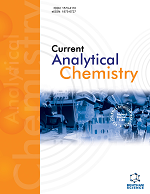- Home
- A-Z Publications
- Current Analytical Chemistry
- Previous Issues
- Volume 13, Issue 1, 2017
Current Analytical Chemistry - Volume 13, Issue 1, 2017
Volume 13, Issue 1, 2017
-
-
A Review: Stripping Voltammetric Methods as a High Sensitive Strategy for Trace Analysis of Ions, Pharmaceutical and Food Samples
More LessAuthors: Somaye Cheraghi, Mohammad A. Taher, Majede Bijad and Hasan SadeghifarElectrochemical techniques are powerful tools for trace analysis of important food, clinical and environmental compounds in real samples. In between electrochemical methods, stripping voltammetry technique is a very selective and highly sensitive method for the determination of nanomolar level of electroactive species in solution. Detection limits for electroactive compounds at sub-ppb concentrations have been r Read More
-
-
-
A Review: Molecularly Imprinted Electrochemical Sensors for Determination of Biomolecules/Drug
More LessAuthors: Mehmet Lutfi Yola and Necip AtarThe interdisciplinary field of materials science involves the discovery and design of new materials. Because of this, materials science has effective interest in the fabrication of biosensors/ nanosensors. In this review, we have focused on molecular imprinted electrochemical sensors based nanomaterials such as graphene oxide/carbon nanotubes molecular imprinting has been very effective method to achieve high selectivit Read More
-
-
-
Electrochemical Aptasensors for Early Cancer Diagnosis: A Review
More LessAptamers are specific oligonucleotides selected invitro which bind to target molecules with high affinity and specificity like antibody-antigen interactions. For that reason, these synthetic oligonucleotides also known as “artificial antibodies”, offer great potential as bio-recognition elements in biosensors. Electrochemical sensors, as biosensors, are very attractive to early diagnosis of cancer as these devices are fast, portable Read More
-
-
-
Nano-Composite Carbon Paste Electrochemical Sensors for Monitoring of Lead Ions in Real Samples
More LessBackground: Determination of heavy and transition metal ions, like lead, especially with the aid of portable, user fiendly, and accurate and precise devices has long been an interesting area in analytical applications, especially in the case of environmental and biological samples. In this light, and given the facility, speed, accuracy, precision and also moderate costs of electrochemical monitoring techniques, these methods have be Read More
-
-
-
Electrocatalytic Determination of Cysteamine Uses a Nanostructure Based Electrochemical Sensor in Pharmaceutical Samples
More LessAuthors: Sadegh Salmanpour, Maryam Abbasghorbani, Fateme Karimi, Razie Bavandpour and Yangping WenThe electrochemical bahaviour of cysteamine (CA) has been investigated by synergic effect of acetylferrocene (AF) and NiO/CNT nanocomposite at a surface of carbon paste electrode (AF/NiO/CNTs/CPE). Voltammetric techniques were used to investigate the suitability of AF/NiO/CNTs/CPE for the electrocatalytic oxidation of CA in pH=7.0 as a suitable condition in voltammetric analysis. AF/NiO/CNTs/CPE shows a dynamic range to el Read More
-
-
-
Application of CdO/SWCNTs Nanocomposite Ionic Liquids Carbon Paste Electrode as a Voltammetric Sensor for Determination of Benserazide
More LessAuthors: Elham Rahmanifar, Mehdi Yoosefian and Hassan Karimi-MalehBackground: Benserazide is an important catechol drug that has been comprehensively used as an irreversible inhibitor of peripheral aromatic amino acid decarboxylase. It is an important drug with wide application in treatment of Parkinson's disease. Therefore, the determination of this drug is very important in biological samples. Methods: According to importance of BZ in biological and pharmaceutical samples, we focu Read More
-
-
-
Ionic Liquids Based Polymeric Membrane Drug Sensors
More LessAuthors: Farnoush Faridbod and Atefeh ShafaatBackground: Application of room temperature ionic liquids (RTILs) in making potentiometric drug sensors is a new strategy to improve the response mechanism. The response of the sensors generally depends on the polymeric membrane ingredients; amount of sensing material, type of plasticizer and ionic additive. Sensing element of a drug sensor which is the most important component of the membrane can be an ion- Read More
-
-
-
Biomimetic Electrochemical Sensors Based on Imprinted Polymers for Determination of Mercury Ion
More LessAuthors: M. R. Ganjali, T. Alizadeh, B. Larijani, M. Aghazadeh, E. Pourbasheer and P. NorouziBackground: Mercury is a highly hazardous heavy metal which can seriously affect the human health. Many analytical methods such as cold vapor atomic absorption spectroscopy, inductively coupled plasma optical emission spectrometry (ICP-OES), and inductively coupled plasma mass spectrometry (ICP-MS), have been reportedly used for the the determination of mercury in different samples. These techniques analyze Read More
-
-
-
Application of New Advanced Electrochemical Methods Combine with Nano-Based Materials Sensor in Drugs Analysis
More LessAuthors: P. Norouzi, H. Haji-Hashemi, B. Larijani, M. Aghazadeh, E. Pourbasheer and M. R. GanjaliBackground: Many instruments have been developed for use in a variety of situations to facilitate the application of nano-based sensors, avoiding expensive and time-consuming procedures. Modified electrochemical methods are precise and sensitive analytical methods with excellent limits of detection. In these systems the analytical information is obtained from the electrical signal that results from the interaction of the drug Read More
-
-
-
High Sensitive Nanostructure Square Wave Voltammetric Sensor for Determination of Vanillin in Food Samples
More LessAuthors: Mohammad A. Khalilzadeh and Zahra ArabVanillin (VAL) is an important flavoring agent in foods, beverages, and pharmaceuticals samples. It is a more atractive food additive as flavor enhancer. Therefore, determination of VAL is important in food industrials. A new method for the determination of VAL in food samples was developed by sqaure wave voltammetry using carbon paste electrode modified with CuFe2O4 nanoparticles and ionic liquid as a working Read More
-
Volumes & issues
-
Volume 21 (2025)
-
Volume 20 (2024)
-
Volume 19 (2023)
-
Volume 18 (2022)
-
Volume 17 (2021)
-
Volume 16 (2020)
-
Volume 15 (2019)
-
Volume 14 (2018)
-
Volume 13 (2017)
-
Volume 12 (2016)
-
Volume 11 (2015)
-
Volume 10 (2014)
-
Volume 9 (2013)
-
Volume 8 (2012)
-
Volume 7 (2011)
-
Volume 6 (2010)
-
Volume 5 (2009)
-
Volume 4 (2008)
-
Volume 3 (2007)
-
Volume 2 (2006)
-
Volume 1 (2005)
Most Read This Month
Article
content/journals/cac
Journal
10
5
false
en


